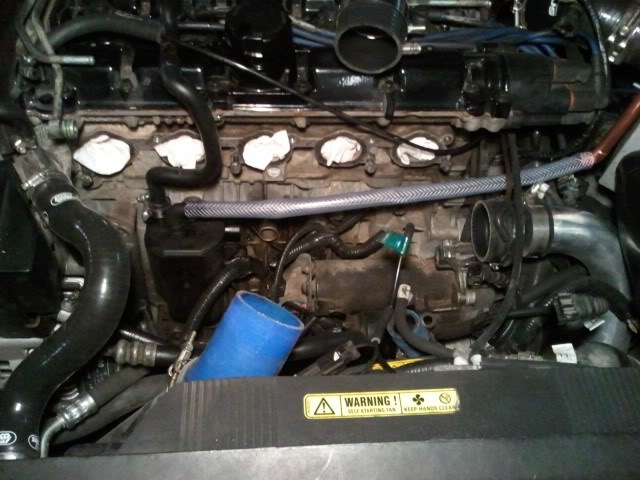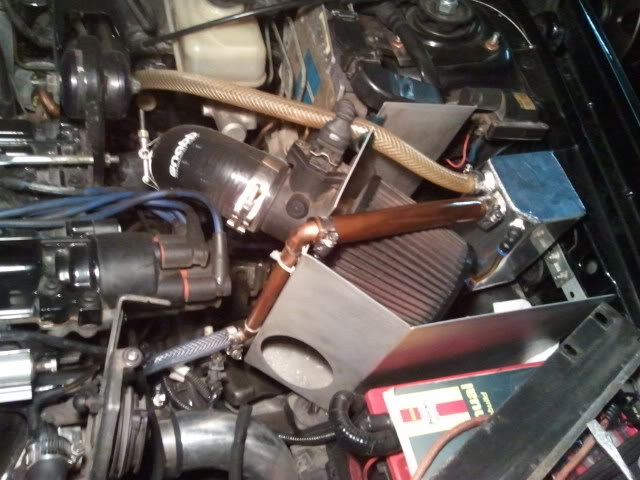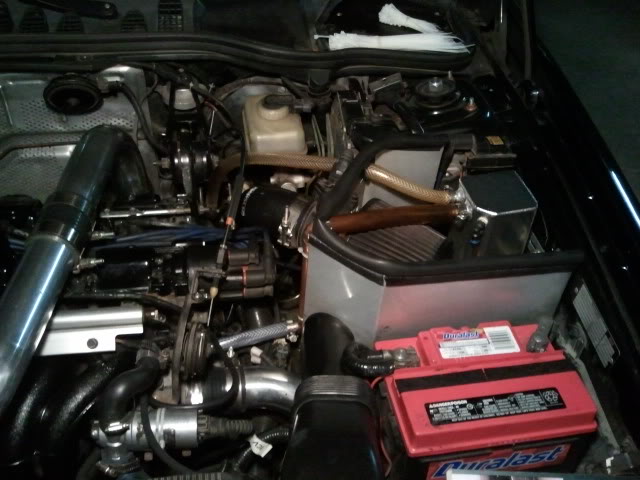New Catch Can (make your PCV system more efficient)
#1
For people looking to put in catch cans, my last one that I posted pics of I took out because the ports were too small and i was still getting crank case pressure. Put in a new one with large 5/8" ports. The inlet line is an experimental route right now, I want to see if it's going to work or not with the two 90* bends, there's mixed opinions about it.
I have the insulator from the original PCV line around the hose to protect it from the heat from the engine.


I have the insulator from the original PCV line around the hose to protect it from the heat from the engine.


#2
#3
It's mostly just deciding which catch can you want to go with, eBay has a huge selection, finding the place to mount it and routing it however you want. That white hose that's in the pictures was the hose included with the CC, and then I just used some copper tube and couplers and little bit more 5/8"ID hose to complete the inlet side.
#4
#5
#7
It's been working, I've been draining the catch can. But I have a Stage III Rica tune coming in a week or so and don't want to be running more boost with those 90* bends. So I'm getting some more hose today to run hose along the front of the intake shield and then to the catch can to make the transition a little more smoother.
#9
The breather box doesn't get full, but when you do high RPM/WOT runs, the breather box doesn't catch all of the blow by that otherwise gets redistributed back into the intake pipe via the PTC. The CC catches blow by and condensation that would otherwise go back into your engine. Eventually, I'm going to get rid of the PTC all together and just have a catch can and vent to atmosphere.
#10
#11
Think about pouring oil into your turbo. I don't think its harmful to the motor but ever seen the intake side of the turbo and how its always black...that's from the oil being dumped into it. I would say yes, its harmful to the turbo since that oil can cause weight/balance issues. One of these days I am going to add a catch can.
The PCV system plugs from sludge and time.
The PCV system plugs from sludge and time.
Last edited by boxpin; 12-06-2016 at 11:30 AM.
#12
Just think, all that **** that my catch can is catching would otherwise be dumped back into your engine, first going through all of your intercooler piping. No thank you. Plus, at higher boost and what not, you create more blow by. I would like to get a baffled catch can eventually to catch what makes it past the catch can and then just vent to atmosphere somewhere and eliminate the PCV altogether.
Speaking of which, anyone know what the vac line on the PTC that goes to the intake manifold does or what it's for? If I eliminate the PTC, do I still need that vac line there?
Speaking of which, anyone know what the vac line on the PTC that goes to the intake manifold does or what it's for? If I eliminate the PTC, do I still need that vac line there?
#13
Yes, PTC needs that vacuum line. PCV system will not operate without that vacuum connection.
PTC nipple has a dual function: it is a heater and a valve. PTC's job is to vaporize moisture collected in the crankcase under 2 conditions: start-up and very cold ambient temperature (winter).
Electrical connections make it operate as a PTC heater. Due to the PTC principles, the colder the incoming air, the hotter the heater element is.
Vacuum line (from the tree on the Intake Manifold) makes it operate as a regular PCV valve -- which variably opens and closes based on the vacuum differential between crankcase and intake manifold.
PTC nipple has a dual function: it is a heater and a valve. PTC's job is to vaporize moisture collected in the crankcase under 2 conditions: start-up and very cold ambient temperature (winter).
Electrical connections make it operate as a PTC heater. Due to the PTC principles, the colder the incoming air, the hotter the heater element is.
Vacuum line (from the tree on the Intake Manifold) makes it operate as a regular PCV valve -- which variably opens and closes based on the vacuum differential between crankcase and intake manifold.
#14
#15
The PTC-heater function is to help fight against throttle icing. Especially in turbo/intercooler cars, driven in colder climates this is an important function. NA cars have the thermostatic pre-heater. Turbos have the PTC nipple. (PTC is in fact heater and thermostat in one single device).
If you eliminate the PTC, and instead design/implement a custom PCV, yes, you can just cap that vacuum line at the tree or use that line to your new PCV, as reference vacuum.
You would also need to cap both ports at the PTC (crankcase/oil separator line port and vacuum port), or get a NA intake pipe from the air filter to the turbo.
Sludge is more of an indication of oil separator failure. PTC needs to be cleaned periodically. Some people think that PTC opening is too small. I don't think so -- the regular PCV valve on my 5.8L Ford wasn't any larger. At 10-15 psi pressure there is a lot of air/gas that goes through that. It's not supposed to be another intake.
I gather that you want to modify the PCV so that it can re-introduce crankcase gases post-turbo? In other words, you don't want crankcase gases to go through the turbo. Why didn't Volvo set up the PCV system that way? I don't know why, but I like to know that reason.
If you eliminate the PTC, and instead design/implement a custom PCV, yes, you can just cap that vacuum line at the tree or use that line to your new PCV, as reference vacuum.
You would also need to cap both ports at the PTC (crankcase/oil separator line port and vacuum port), or get a NA intake pipe from the air filter to the turbo.
Sludge is more of an indication of oil separator failure. PTC needs to be cleaned periodically. Some people think that PTC opening is too small. I don't think so -- the regular PCV valve on my 5.8L Ford wasn't any larger. At 10-15 psi pressure there is a lot of air/gas that goes through that. It's not supposed to be another intake.
I gather that you want to modify the PCV so that it can re-introduce crankcase gases post-turbo? In other words, you don't want crankcase gases to go through the turbo. Why didn't Volvo set up the PCV system that way? I don't know why, but I like to know that reason.
#16
Rspi:
The catch-can helps with removing sludge/oil from turbo and intercooler. They are a good thing and are in addition to the oil separator (breather). In our cars, the location of the oil separator / breather is bad. As engines get older, more oil/gas mix passes through the pistons rings into the crankcase. Since the breather box is full, this oil/gas goes through the PTC to the turbo and intercooler. It deposits at the bottom of the intercooler, after it has coated intercooler walls with oil, which also reduces intercooling.
So adding another oil separator (breather box / catch-can) on an accessible location is good practice. Gilber33 has been emptying quite a bit of sludge from the catch-can.
However the catch-can is not a PCV valve. Many of us think of the PCV valve as that rickity-rickity rubber/plastic elbow or nipple. There is quite a science behind the PCV system, that makes the PCV valve such a small miracle. These engines are designed with PCV; without it pressures would blow seals apart quickly, as we all know.
Honestly Gilber33 -- the more I think about this -- there are many calculations and considerations that go into designing another PCV system. There are many variables, such as crankcase pressure, intake charge pressure, rpm, intake air temperature, blah, blah., at different points on the map
I am not saying you shouldn't try it; on the contrary -- go for it.
The catch-can helps with removing sludge/oil from turbo and intercooler. They are a good thing and are in addition to the oil separator (breather). In our cars, the location of the oil separator / breather is bad. As engines get older, more oil/gas mix passes through the pistons rings into the crankcase. Since the breather box is full, this oil/gas goes through the PTC to the turbo and intercooler. It deposits at the bottom of the intercooler, after it has coated intercooler walls with oil, which also reduces intercooling.
So adding another oil separator (breather box / catch-can) on an accessible location is good practice. Gilber33 has been emptying quite a bit of sludge from the catch-can.
However the catch-can is not a PCV valve. Many of us think of the PCV valve as that rickity-rickity rubber/plastic elbow or nipple. There is quite a science behind the PCV system, that makes the PCV valve such a small miracle. These engines are designed with PCV; without it pressures would blow seals apart quickly, as we all know.
Honestly Gilber33 -- the more I think about this -- there are many calculations and considerations that go into designing another PCV system. There are many variables, such as crankcase pressure, intake charge pressure, rpm, intake air temperature, blah, blah., at different points on the map
I am not saying you shouldn't try it; on the contrary -- go for it.
Last edited by Henry10; 03-01-2011 at 04:45 PM. Reason: spelling PVC or PCV
#17
I'm not running the stock intake pipe as it is. You can kind of see it here:

So I would either purchase another pipe like this without the hole in it, or just cap the PTC for now, which isn't a big deal.
I know of several heavily modified 850s that have already eliminated the PTC altogether to completely eliminate re-introducing blow by into the engine. My car is quickly turning into a summer car only and not a DD. So, chances are it will not be in cold temps very much longer, even less than it is now. I catch a lot of the thicker blow by (the milky brown looking ****), but some of the thinner/lighter oil that passes through the PCV system makes its way back through the catch can system.
Also, that current set up that I have with the copper piping going up the intake shield, although it is pretty, is gone and I've introduced a new routing for it that will have softer turns and no more 90* bends like that one. Will post pics of it later tonight.

So I would either purchase another pipe like this without the hole in it, or just cap the PTC for now, which isn't a big deal.
I know of several heavily modified 850s that have already eliminated the PTC altogether to completely eliminate re-introducing blow by into the engine. My car is quickly turning into a summer car only and not a DD. So, chances are it will not be in cold temps very much longer, even less than it is now. I catch a lot of the thicker blow by (the milky brown looking ****), but some of the thinner/lighter oil that passes through the PCV system makes its way back through the catch can system.
Also, that current set up that I have with the copper piping going up the intake shield, although it is pretty, is gone and I've introduced a new routing for it that will have softer turns and no more 90* bends like that one. Will post pics of it later tonight.
#18
As I understand, the OEM breather box serves as a breather, i.e. allows the crankcase to inhale fresh air. Correct? If so, something needs to be done to allow this function to continue.
Secondly, crankcase needs to exhale, but unlike inhaling, it exhales at certain conditions, not all. That is why the PCV valve is a variable opening-closing valve; it's not an on-off valve. Sometimes, it does restrict almost all flow.
As the last resort, you could theoretically go buy a $ 2.50 any-PCV valve, hook it up somewhere. You could experiment with this. I would also use some gauges to monitor engine loads, and to make sure not too much pressure is in the crankcase.
Secondly, crankcase needs to exhale, but unlike inhaling, it exhales at certain conditions, not all. That is why the PCV valve is a variable opening-closing valve; it's not an on-off valve. Sometimes, it does restrict almost all flow.
As the last resort, you could theoretically go buy a $ 2.50 any-PCV valve, hook it up somewhere. You could experiment with this. I would also use some gauges to monitor engine loads, and to make sure not too much pressure is in the crankcase.
Last edited by Henry10; 03-01-2011 at 05:15 PM. Reason: Clarification
#19
As I understand, the OEM breather box serves as a breather, i.e. allows the crankcase to inhale fresh air. Correct? If so, something needs to be done to allow this function to continue.
Secondly, crankcase needs to exhale, but unlike inhaling, it exhales at certain conditions, not all. That is why the PCV valve is a variable opening-closing valve; it's not an on-off valve. Sometimes, it does restrict almost all flow.
As the last resort, you could theoretically go buy a $ 2.50 any-PCV valve, hook it up somewhere. You could experiment with this. I would also use some gauges to monitor engine loads, and to make sure not too much pressure is in the crankcase.
Secondly, crankcase needs to exhale, but unlike inhaling, it exhales at certain conditions, not all. That is why the PCV valve is a variable opening-closing valve; it's not an on-off valve. Sometimes, it does restrict almost all flow.
As the last resort, you could theoretically go buy a $ 2.50 any-PCV valve, hook it up somewhere. You could experiment with this. I would also use some gauges to monitor engine loads, and to make sure not too much pressure is in the crankcase.
And I'm not exactly sure where the system would be drawing in fresh air besides the hose coming off of the PTC, but that is constantly blowing into the intake tube, hence why you get oil in there.
#20

